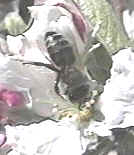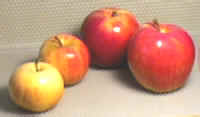
Why Manage Pollination?
You manage the soil, the water, the pests. But many growers don't manage pollination, because they don't recognize what poor pollination costs them. If you lose 30% of the value of a crop, you've wasted that much of all the other inputs.
|
Many growers think that a bee visiting a blossom will accomplish its pollination. In most cases, however, a single bee visit is not sufficient to make a quality fruit or vegetable. One visit may be enough for easy-to-pollinate peaches, but for apples, melons and many other crops we would like to accomplish 15 or 20 visits. |
Aborted blossoms are usually recognized as a symptom of pollination failure. Fruit that starts to develop, then molds or drops off, may not be recognized. And often, poorly pollinated fruit will develop further but show characteristics that are obvious to the trained eye.
| Badly shaped or undersized fruit is an important clue to lack of sufficient bee visits. This melon will never make it to market, because one end is unpollinated and it will not develop. This is an extreme case, perhaps representing only one visit by a bee. |
|
| Pollination of the seeds is the key factor in the development and sweetening of the flesh of the fruit. |
|
If we can get 1000 grains of compatible pollen, evenly distributed across the stigma of the flower, we can get 90% of the seeds pollinated and make a quality melon. |
|
This poor tasting, white-seeded, pink-fleshed melon made it to market, but it shouldn’t have. Consumers may think it unripe or overfertilized. They‘ll probably think twice about the next purchase. In reality the melon will never ripen further, because it is only half pollinated. Growers who do not have sufficient hives of bees in their fields will lose a lot of quality in their production. |
Summer squash may get partly pollinated and make a fruit that gets to market. Both zuchinni and yellow squash that is poorly pollinated will not fill out well. The shrunken sections may be wrinkled and they will be quick to spoil. The zuke on the left has most of the seeds pollinated. The other two are missing many seeds in the centers. |
|
|
Knotty, or curled cukes tell of the lack of bee visits in the blossoms. The one on the bottom is an example, while the top one is perfectly pollinated. Poorly pollinated cukes are slow growing, and they get tough by the time they get to the same size as a good one should be. They also are prone to spoilage in the poorly pollinated sections. |
An orchardist can spend a lot of money trying to get good apples. He can do everything right but pollination, and wind up with unprofitable bag apples such as the ones on the left with an average of three seeds. The apples on the right characteristically have 8-9 seeds and are sold from the fancy fruit shelf, where they make a profit. With other crops, poor pollination may not be so obvious. Cantaloupes that run small and are not sweet, empty spaces in bean seed pods, or just generally small yields, can be symptoms. |
 |
Look at the results
of your crop production.
Do you need better pollination management?